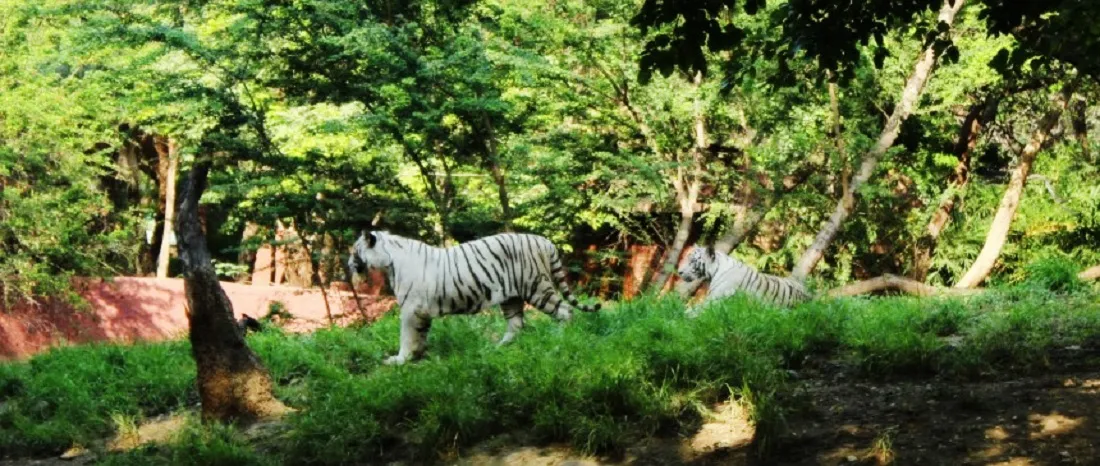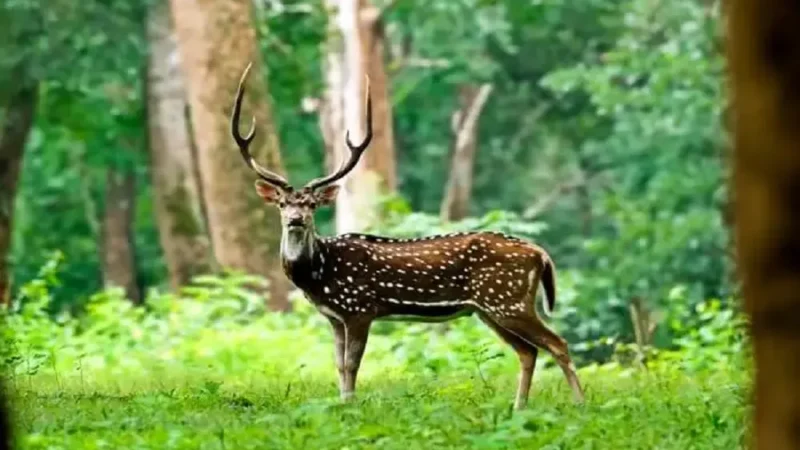National Parks in Telangana

Table of Contents
ToggleTelangana National Parks -
Welcome to the enchanting world of Telangana’s national parks! Nestled amidst the diverse landscapes of this southern Indian state, Telangana’s national parks offer a mesmerizing retreat for nature lovers and wildlife enthusiasts. With their rich biodiversity, scenic beauty, and unique ecosystems, these national parks provide a sanctuary for a wide range of flora and fauna. From the majestic tigers of Kawal Wildlife Sanctuary to the serene lakes of Pocharam Wildlife Sanctuary, each park has its own story to tell.
Join us as we embark on a journey to explore the beautiful national parks of Telangana, delving into their wildlife, natural wonders, and the efforts taken to preserve these ecological treasures. Get ready to immerse yourself in the beauty of nature and discover the hidden gems of Telangana’s national parks.
National Parks of Telangana-
1- Kasu Brahmananda Reddy National Park
Kasu Brahmananda Reddy National Park, located in Hyderabad, Telangana, is a prominent urban national park that offers a respite from the city’s hustle and bustle. Named after the former Chief Minister of Andhra Pradesh, the park spans an expansive area and provides a peaceful environment for visitors to connect with nature. Here’s an overview of Kasu Brahmananda Reddy National Park:
- Natural Beauty: The park is renowned for its lush greenery, beautiful landscapes, and diverse flora. It features a mix of open grasslands, dense forests, and water bodies, creating a visually appealing setting. Tall trees, colorful flowers, and well-maintained gardens enhance the park’s natural charm.
- Wildlife: Despite being an urban park, Kasu Brahmananda Reddy National Park is home to various animal species. Visitors may spot spotted deer, blackbucks, Indian foxes, jackals, and different species of reptiles and birds. The park provides a safe habitat for these animals amidst the city’s urban environment.
- Birdwatching: The park is a haven for birdwatchers, attracting diverse avian species. Bird enthusiasts can spot peafowls, partridges, kingfishers, drongos, and many other resident and migratory birds. The park’s tranquil atmosphere and abundance of trees make it an ideal spot for birdwatching and photography.
- Nature Trails and Walkways: Kasu Brahmananda Reddy National Park offers well-maintained walking trails and pathways that wind through its natural surroundings. Visitors can enjoy leisurely walks, jogging, or cycling, immersing themselves in the park’s serene ambiance. The trails allow one to explore the park’s various sections and appreciate its flora and fauna up close.
- Picnic and Recreation Areas: The park features designated picnic spots equipped with benches, tables, and shaded areas, making it a popular destination for families and friends to gather and enjoy outdoor activities. Visitors can relax, picnic, or engage in recreational games surrounded by the park’s tranquil environment.
- Conservation Efforts: The park authorities prioritize conserving the park’s natural resources and wildlife. They work towards maintaining the ecological balance, preserving flora and fauna, and creating awareness among visitors about the importance of environmental conservation.
2- Mahavir Harina Vanasthali National Park:
Mahavir Harina Vanasthali National Park, located near Hyderabad in Telangana, is a beautiful wildlife sanctuary and national park spanning a vast area. Named after the revered Jain saint, Lord Mahavir, this park is renowned for its diverse flora and fauna, making it a popular destination for nature lovers and wildlife enthusiasts. Here’s an overview of Mahavir Harina Vanasthali National Park:
- Wildlife: The park is primarily known for its population of blackbucks, a cultivated and endangered antelope species. Visitors can witness these graceful creatures roaming freely in their natural habitat. Apart from blackbucks, the park is home to other wildlife species such as Indian hare, porcupine, wild boar, mongoose, and various reptiles.
- Avian Delights: Mahavir Harina Vanasthali National Park is a haven for birdwatchers. The park boasts a rich avifauna with numerous resident and migratory bird species. Bird enthusiasts can spot peafowls, partridges, quails, Indian rollers, hoopoes, and a wide array of raptors. The park’s serene environment and varied habitats make it an excellent spot for birdwatching and photography.
- Flora and Vegetation: The park is characterized by diverse vegetation, including dry deciduous forests, grasslands, and thorny scrub forests. The flora consists of tree species such as neem, tamarind, sandalwood, and acacia. The vibrant wildflowers dot the landscape and add to the park’s natural beauty.
- Nature Trails and Interpretation Center: Mahavir Harina Vanasthali National Park offers well-laid-out nature trails that allow visitors to explore its pristine surroundings. These trails provide opportunities for peaceful walks and hikes while immersing oneself in the tranquility of nature. The park also features an Interpretation Center where visitors can learn about the park’s wildlife, ecology, and conservation efforts.
- Conservation and Eco-Tourism: The park authorities emphasize the importance of wildlife conservation and eco-tourism. They undertake various initiatives to protect natural habitats, promote awareness about the park’s biodiversity, and educate visitors about the significance of wildlife conservation.
3- Mrugavani National Park
Mrugavani National Park, located on the outskirts of Hyderabad in Telangana, is a picturesque wildlife sanctuary that offers a serene escape into nature. Spread across a sprawling area, and the park is known for its diverse flora and fauna, making it a popular destination for nature lovers, birdwatchers, and wildlife enthusiasts. Here’s an overview of Mrugavani National Park:
- Biodiversity: Mrugavani National Park boasts a rich biodiversity with various plant and animal species. The park has several mammals, including spotted deer, wild boars, Indian foxes, jackals, and porcupines. Visitors may also spot reptiles like monitor lizards, snakes, and various species of butterflies and insects.
- Avian Paradise: The park is a haven for birdwatchers, attracting many avian species. Bird enthusiasts can spot colorful birds such as peafowls, Indian rollers, kingfishers, partridges, bulbuls, and many more. The park’s serene environment and diverse habitats provide an ideal setting for birdwatching and photography.
- Flora and Fauna: Mrugavani National Park is adorned with lush greenery and diverse vegetation. It features dry deciduous forests, rocky terrains, and grasslands, creating a varied landscape. The park is home to various tree species, including teak, neem, sandalwood, and bamboo, providing a habitat for the park’s wildlife.
- Nature Trails: The park offers well-maintained nature trails that allow visitors to explore its natural beauty on foot. Walking through the trails, visitors can immerse themselves in the park’s tranquility, observe the flora and fauna up close, and enjoy the soothing sounds of nature. The trails allow one to appreciate the park’s serene ambiance and spot wildlife.
- Conservation and Eco-Tourism: Mrugavani National Park strongly emphasizes conservation and eco-tourism. The park authorities undertake initiatives to protect and preserve the park’s natural resources, raise awareness about wildlife conservation, and promote sustainable tourism practices. They also organize educational programs and nature camps to create environmental awareness among visitors, especially children.
4- Kawal Wildlife Sanctuary
Kawal Wildlife Sanctuary, located in the Adilabad district of Telangana, is a magnificent protected area that showcases the state’s diverse wildlife and natural beauty. It is one of the oldest sanctuaries in Telangana and is known for its rich biodiversity and pristine landscapes. Here’s an overview of Kawal Wildlife Sanctuary:
- Wildlife: Kawal Wildlife Sanctuary is a haven for enthusiasts and nature lovers. The sanctuary is home to various animal species, including the majestic Royal Bengal Tiger, the main attraction for visitors. Other prominent wildlife species in the sanctuary include leopards, sloth bears, dholes (Indian wild dogs), hyenas, sambar deer, chital (spotted deer), and many more. The sanctuary provides a natural habitat for these species and offers wildlife sightings and photography opportunities.
- Avian Delights: The sanctuary is a paradise for birdwatchers, boasting a diverse avian population. Bird enthusiasts can spot various resident and migratory bird species, including peafowls, Indian rollers, hornbills, vultures, and woodpeckers. The sanctuary’s rich birdlife and pristine surroundings make it ideal for birdwatching and nature photography.
- Flora and Vegetation: Kawal Wildlife Sanctuary is characterized by its dense forests, teeming with various flora and vegetation. The sanctuary features dry deciduous forests, mixed forests, bamboo groves, and grasslands. The vegetation includes teak, bamboo, sandalwood, neem, tamarind, and many other tree species. The sanctuary’s diverse plant life adds to its ecological significance and provides a habitat for the resident wildlife.
- Nature Trails and Safaris: The sanctuary offers nature trails and jeep safaris, allowing visitors to explore its captivating landscapes and wildlife. Guided nature walks, and safaris provide a chance to witness the sanctuary’s flora and fauna up close, offering an immersive experience in the wilderness. It is an excellent opportunity to learn about the sanctuary’s ecosystem, conservation efforts, and the importance of preserving natural habitats.
- Conservation Efforts: Kawal Wildlife Sanctuary is crucial in conserving wildlife and their habitats. The sanctuary authorities and various conservation organizations actively work towards preserving the region’s biodiversity. They undertake measures to protect endangered species, prevent poaching and illegal activities, and promote awareness about wildlife conservation among visitors and local communities.
5- Pocharam Wildlife Sanctuary
Pocharam Wildlife Sanctuary, located in Medak district of Telangana, is a charming natural haven that showcases the region’s diverse wildlife and scenic landscapes. Nestled around the beautiful Pocharam Lake, the sanctuary is known for its rich biodiversity and as an essential habitat for various flora and fauna. Here’s an overview of Pocharam Wildlife Sanctuary:
- Pocharam Lake: The sanctuary comes from the picturesque Pocharam Lake, which forms the region’s centerpiece. The lake, surrounded by lush greenery and serene surroundings, attracts various bird species. It serves as a vital watering hole for wildlife and provides a scenic backdrop for visitors.
- Avian Paradise: Pocharam Wildlife Sanctuary is a paradise for birdwatchers and a recognized bird conservation site. The sanctuary is home to a diverse range of avian species, including migratory birds that visit during winter. Bird enthusiasts can spot pelicans, storks, herons, ibises, ducks, geese, and numerous other waterbirds. The sanctuary’s tranquil environment and the lake’s rich biodiversity make it an ideal spot for birdwatching and photography.
- Wildlife: While the sanctuary focuses primarily on avifauna, it is also home to various animal species. Visitors may encounter animals like chital (spotted deer), wild boars, Indian porcupines, and peafowls. Reptiles like snakes and monitor lizards can also be spotted in the sanctuary. The diverse wildlife adds to the sanctuary’s charm and provides a unique opportunity for wildlife enthusiasts.
- Flora and Vegetation: Pocharam Wildlife Sanctuary features a mix of vegetation, including dry deciduous forests, scrublands, and grasslands. The sanctuary is adorned with various tree species, such as teak, neem, bamboo, tamarind, and acacia. The lush greenery and colorful wildflowers enhance the sanctuary’s natural beauty and create a favorable environment for wildlife.
- Nature Trails and Eco-Tourism: The sanctuary offers nature trails and eco-tourism activities for visitors to explore its natural wonders. Walking through the trails allows visitors to appreciate the sanctuary’s flora, observe birdlife, and experience the peaceful ambiance. Lake boating facilities provide a unique perspective and allow visitors to get closer to the sanctuary’s avian residents.
- Conservation Efforts: Pocharam Wildlife Sanctuary is dedicated to conserving its unique ecosystem. The sanctuary authorities, in collaboration with environmental organizations, actively work towards protecting the sanctuary’s wildlife and their habitats. They strive to create awareness about conservation, promote responsible tourism, and educate visitors about the importance of preserving natural resources.
Conclusion -
In conclusion, Telangana’s national parks are a treasure trove of natural wonders, offering a haven for wildlife, breathtaking landscapes, and opportunities for nature enthusiasts to reconnect with the great outdoors. From the thrilling encounters with the Royal Bengal Tigers in Kawal Wildlife Sanctuary to the serene beauty of Pocharam Wildlife Sanctuary’s lake, each national park in Telangana has something unique to offer. The conservation efforts undertaken by the park authorities and environmental organizations ensure the preservation of these valuable ecosystems for future generations. Whether you’re a wildlife enthusiast, a bird lover, or simply seeking solace in nature, Telangana’s national parks beckon with their beauty and biodiversity. So, plan your visit, immerse yourself in the tranquility, and create unforgettable memories as you witness the wonders of Telangana’s national parks.

